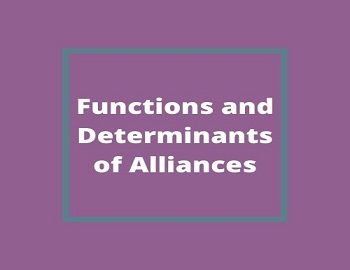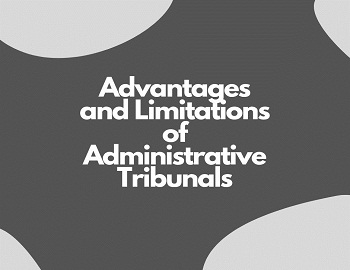Table of Contents
Functions and Determinants of Alliances:
The political significance of alliances writes R. Osgood is all the greater in this era of popular (including undemocratic) governments because alliances generally presuppose national or ideological affinities that go beyond the matter-of-fact expediencies involved in more restricted contracts.
In fact, ‘alliances are an integral part of international politics. They are one of the primary means by which states seek the co-operation of other states in order to enhance their power and to protect and advance their interest. This instrument of cooperation is so pervasive that every state must have an alliance policy, even if its purpose is only to avoid alliances”.
Nature- Alliances can be defined in the words of Osgood as a formal agreement that pledges states to co-operate in using their military resources against a specific state or states and usually obligates one or more of the signatories to use force, or to consider (unilaterally or in consultation with allies) the use of force, in specified circumstances.
As such alliances differ from collective security. Alliances generally reflect more than “a single” explicit and identical interest between members. Some interests are specified in the agreement while some are left unspecified.
Function of Alliances:
Prof. Robert E. Osgood has nicely explained the following four functions of an alliance. The same can be discussed as under-
(1) Accretion of External Power- The accretion of power entails increasing the military power of allies by combining resources and electing positive cooperation. This has been the basic and the most common function of alliances. The ultimate purpose of accretion is to enhance the relative power of one or more allies against another state or states for defence or offensive ends (although some states, especially the smaller ones, may want power largely in the form of status).
(2) Internal Security- It is sometimes a more important function of alliances for a weak state than the accretion of its external power. In recognition of the international significance of internal threats and developments, which are often supported covertly from outside, the alliance may be intended principally to enhance the security or stability of an ally’s government or regime, often by legitimizing material assistance or military intervention against internal opposition. This purpose is usually not made explicit, however, since the intervention in the domestic affairs of another state, even at that state’s invitation, has acquired a stigma in the age of popular national governments.
(3) Restraint of Allies- Next to accretion, the most important function of alliances has been to restrain and control allies, particularly in order to safeguard one ally against actions of another that might endanger its security or otherwise jeopardize its interests. This function may be accomplished directly by a pledge of non-intervention or by other reassurances that one ally will not contravene the interests of another, or it may be the by-product of commitments that limit an ally’s freedom of action and provide its partner with access to, and influence upon its government.
(4) International Order- It is the broadest and the least attainable function of an alliance. An alliance may aim at preserving harmony among its members and establishing an international order- that is, a stable, predictable, and safe pattern of international policies- within an area of common concern. In its ultimate form, this function of an alliance becomes collective security. In different ways, the Quadruple Alliance after the Napoleonic Wars and the OAS have exercised this function of maintaining order. Before the onset of the cold war, the United States expected the Big Three, as the core of the United Nations, to be guarantors of new world order. Some people believe that NATO has served indirectly as a framework for a new Western European order or even the Atlantic Community.
Determinants of Alliances:
Among the various determinants that may affect the creation of alliances, the following determinants as given by Prof. Robert E. Osgood are worth noting-
(1) The pattern of conflicting and converging interests- If states have no interests that they need to support by military power against other states, they lack sufficient incentives to form alliances. If two or more states feel no need for each other’s assistance in improving their military capacity to protect the advance of their interests against other states, an alliance is not likely to be created, and an existing alliance is likely to erode.
Even if mutual military needs exist, the creation or maintenance of all alliances often requires a convergence of interests that goes beyond a common interest in security. Most notably there must be sufficient affinity and harmony of policies. The importance of this convergence is directly proportional to the comprehensiveness and mutuality of the alliance’s obligations and to the duration of the security threat.
In the case of existing or prospective alliances in which inter-allied control or order is an important function, the urgency of a commonly felt threat to security may be less determinative, but then the pattern of conflicting, as well as converging interests among allies, becomes crucial.
(2) The Distribution of Military Power- The formation and preservation of an alliance depends on the military capacity of states as well as their political incentive to cooperate militarily (even though one state may only provide bases and facilities or promise to remain neutral). The capacity of states to help each other depends on the relationship of the concerned power to the power of their potential adversaries.
The interaction of this distribution of power with the pattern of interests among states affects not only the desirability and feasibility of alliances but also the characteristics of alliances and the nature of alliance policies. For example, it establishes the polarity of power, or, more specifically, the number of states that are engaged in a dominant international political conflict, are projecting decisive military power and are undertaking independent military commitments. Whether there are two or many “poles of power”, has many implications for alliances.
The changing distribution of power between an alliance and its opponents may affect the cohesion of an alliance. For example, adverse changes in the external distribution of power may create dissatisfaction with the distribution within an alliance. Such dissatisfaction and the effort to overcome it may change alliance policies and even alliance functions.
(3) Alliance Capacity- Even if the preceding determinants should support the creation or maintenance of an alliance, the states that are concerned may lack the certain minimum military and political prerequisites. These are- (a) enough internal stability, executive authority, and economic strength, along with a sufficiently coherent and predictable foreign policy, to enable a state to be a reliable collaborator and (b) adequate capacity of a state to dispose of its military power effectively for the benefit of an ally (Again, the capacity of one state may be confined to a relatively passive role).
(4) Alliance Mindedness- Related to the preceding determinant, and also of special significance for the future of alliance among the small and newer states in the Third World, is the subjective attitude of the government towards alliances. For example, small, recently independent states are averse to alliances with the chief protagonists of the cold war. The subjective inclination or disinclination to enter alliances may be closely related to considerations of expediency; yet it goes beyond the sheer reasoned calculation of security requirements and reflects hope, suspicions, and ideals that are deeply rooted in the national culture and experience. In America’s period of physical invulnerability and political insulation, its high-principled denigration of alliances was as important as its glorification of them in the cold war.
Conclusion- To conclude our study of alliances we may say in the words of Osgood that in the cold war, alliances have been as important in international politics as in any other period of history. But among the advanced states, several developments have reduced their flexibility (but, by the same token, enhanced their stability). Their primarily deterrent function, the inhibitions against major states going to war in the nuclear age, the increased importance of peacetime military force, the sensitivity of government to public sentiment and ideological position, the persistence of a dominant international conflict and structure of power that have been essentially bipolar- all these developments have tended to restrict the number of alliances and the frequency of shits of alliance among major states.









Comments (No)